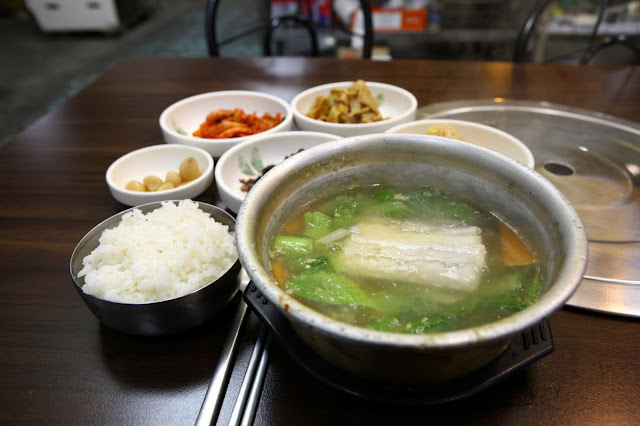This time around I would like to introduce Jeju delicacies –
seafood based of course and all are fish dish, no moving baby octopus so don’t
you worry. Hehhehee…
Just like Malaysia, South Korea delicacies are segmented of
differentiated by location, natural resources, local customs and historical
events. This segmentation translated in their custom, lifestyle and delicacy
till current times.
Jeju being an island has a impacted in their daily diet and
as paddy is not conducive to be farmed here due to lack of fresh water hence
grainy crops such as buckwheat, millet and barley is consumed more here.
Seafood mixed with grains can easily be seen here such as japgokbap, salted
fish and soup dishes is also a great favourite.
Let’s get started shall we…
Jeonbokjuk (Abalone Rice Porridge)
As mentioned in my earlier post on haenyeo (woman divers) diving
for abalone in Jeju, it comes as no surprise that abalone is one of the famous
and must try dish in Jeju. Apparently, the dark murky porridge colour is due to
them cooking and using the abalone internal organs thus the yellowish colour. But
do not be fooled by the colour as the taste is said to be amazing.
I’ve also read it somewhere stating that if you are in Jeju,
you’ll find that every coastal village has a Haenyeo House serving jeonbokjuk
where the abalone is freshly caught by the haenyeo.
Galchi Jorim (Spicy Braised Silver Cutlassfish)
I found out that Jeju is popular for Galchi Jorim, galchi is basically cutlassfish and jorim means braised dish (sautéed or seared lightly and then stewed slowly in a covered pot), regardless whether its vegetables, meats, seafood, or tofu. Cutlassfishes or hairtail fish looks like eel with fang like teeth. Jeju’s cutlassfish is known for its silver white with shining silver body and it is popular among the locals as it is easy to cook ie. Minimal effort is removing its head, tail and internal organs. I can totally understand and relate to this.
The Galchi Jorim soup is often as simple as cutlassfish, pumpkin, cabbage, zucchini and/or radish in a spicy and sweet sauce. Like most East Asian countries, soup dishes pairs well with…. RICE. Oh yah! #FoodTips, for a sweeter taste cutlassfish, October and November is the month to fish. Perhaps to sample them too.
Galchi Guk (Cutlassfishes or hairtail Soup)
Galchi Guk is also best cooked served as clear soup, and
that Galchi pumpkin soup served only in Jeju. Often recommended for those with
hangover.
Haemul Ttukbaegi (Seafood Stew in a Hot Pot)
Seafood-based hot pot is one of the delicacy in Jeju as
well. Using doenjang (fermented soybean paste) boiled together with seafood
such as shrimp, clams, and any shellfish.
Mulheo (Watery sashimi)
Usually taken during in August (the hottest month) as Mulhoe
is served as a cold soup with hoe ie. raw fish. Known as the seafood in water
and the one in Jeju is unique because it includes sea cucumber, abalone, turban
shell and/or damselfish.
What makes Jeju’s Mulhoe different from the rest is that it
uses uncooked doenjang and swindari vinegar. I learnt that Swindari vinegar is
made from fermented barley rice, leaving an acidic after taste. Now, you can
also try okdom (red horsehead) mulhoe and jeonbok (abalone) mulhoe when
visiting Jeju.
Gosh! This kinda makes me feel hungry (googling how to make
Korea-style soup).
#ImagineYourKorea #KTOSuperstarFriends






No comments:
Post a Comment